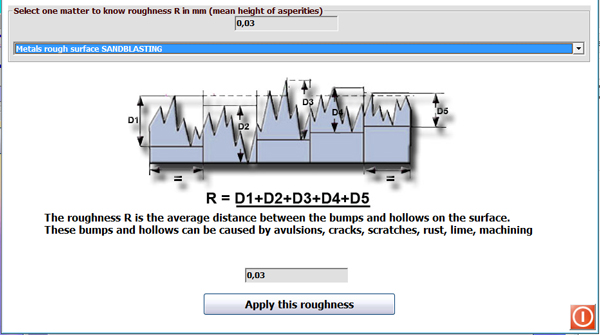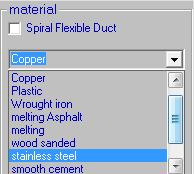- The roughness is a key parameter in the calculation of major head loss in pipes..
- Roughness gives information on the state of the walls in contact with the fluid and acts on the surface friction.
- The roughness of the ducts is a determining factor in the choice of pipe materials in the study of a hydraulic system or ventilation
For practical purposes of calculating the unit varies depending on the application:
- For the study of major head loss in pipes and flat plates surface friction , we use the average roughness in millimeters (R). This is the average of the distances of the protrusions-hollows defect surfaces formed by ribs, grooves, slots or tearing:

With Mecaflux standard software, you can get directly roughness (average roughness depth in millimeters) of the duct or pipe by choosing his material
- The formulas for the estimation of the flow regime (see Colebrook) using a ratio of the average roughness (R) on the diameter (D) of ducts, called relative roughness (D and R in the same unit):R/D
- into the frictional resistance on flat plate, a ratio of surface roughness, consisting of grains of sandwhose diameter, compared to the he bondary layer thickness is used. It is found that when the ratio exceeds 0.5 the roughness starts to play an important role in the frictional resistance on surface
- In naval hydrodynamics an average hull roughness is also used, using the equivalent roughness of grain sands(K), divided by the length of the hull(L):K/L(K and L in the same unit)
- The roughness of the pipes of a given material evolves over time according to the transported fluid (aggressive oxidant, acid, charged with abrasive material..) and operating conditions (constantly into water or exposure time to the air oxidation..). Conduct can become of a costly roughness operating energy and see its real price tenfold over time. The operating time is to apply to the evolution of roughness in the study of the purchase price of ducts. See: sizing Air and water pipes.
Mecaflux Editor roughness:

Choice of roughness according to the material, and the state of ventilation ducts, or hydraulic pipes in the software mecaflux.
more than 140 data roughness can cover all cases encountered in studies of air or water network
Examples of hydraulics networks pipe's roughness
| welded steel | New | 0,04 |
| welded steel | New, covered with bitumen | 0,05 |
| welded steel | Long operation, bitumen partially missing, corrodedés | 0,1 |
| welded steel | For a long time in service uniform corrosion | 0,15 |
| welded steel | The joints without significant inequalities internally coated ur de la couche: 10 mm environ); mauvais état | 0,3 à 0,4 |
| welded steel | Gas mains, after many years of operation ation | 0,5 |
| welded steel | With Simple or double cross riveting coated internally , ou sans revêtement, mais non corrodés | 0,6 à 0,7 |
| welded steel | Coated internally, but not free from oxidation, dirty u cours du service avec de l'eau, mais non corrodés | 0,95 à 1 |
| welded steel | Gas mains, after 20 years of service, stratified deposits és | 1,1 |
| welded steel | With double lateral riveting, not corroded, dirty de service avec de l'eau | 1,2 à 1,5 |
| welded steel | small deposits | 1,5 |
Table roughness few conduits according to their status or number of years of service
